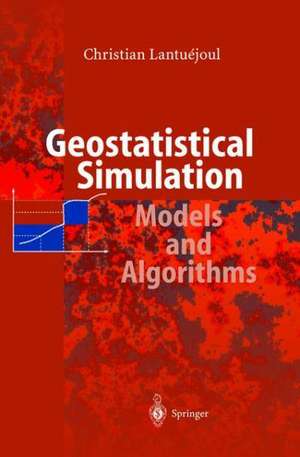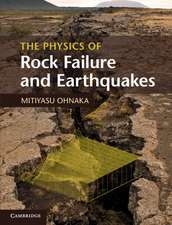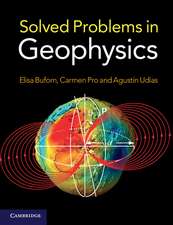Geostatistical Simulation: Models and Algorithms
Autor Christian Lantuejoulen Limba Engleză Paperback – 30 noi 2010
| Toate formatele și edițiile | Preț | Express |
|---|---|---|
| Paperback (1) | 558.63 lei 38-45 zile | |
| Springer Berlin, Heidelberg – 30 noi 2010 | 558.63 lei 38-45 zile | |
| Hardback (1) | 643.16 lei 6-8 săpt. | |
| Springer Berlin, Heidelberg – 9 oct 2001 | 643.16 lei 6-8 săpt. |
Preț: 558.63 lei
Preț vechi: 698.29 lei
-20% Nou
Puncte Express: 838
Preț estimativ în valută:
106.90€ • 114.31$ • 89.13£
106.90€ • 114.31$ • 89.13£
Carte tipărită la comandă
Livrare economică 14-21 aprilie
Preluare comenzi: 021 569.72.76
Specificații
ISBN-13: 9783642075827
ISBN-10: 3642075827
Pagini: 280
Ilustrații: XIII, 256 p. 232 illus., 76 illus. in color.
Dimensiuni: 155 x 235 x 15 mm
Greutate: 0.39 kg
Ediția:Softcover reprint of hardcover 1st ed. 2002
Editura: Springer Berlin, Heidelberg
Colecția Springer
Locul publicării:Berlin, Heidelberg, Germany
ISBN-10: 3642075827
Pagini: 280
Ilustrații: XIII, 256 p. 232 illus., 76 illus. in color.
Dimensiuni: 155 x 235 x 15 mm
Greutate: 0.39 kg
Ediția:Softcover reprint of hardcover 1st ed. 2002
Editura: Springer Berlin, Heidelberg
Colecția Springer
Locul publicării:Berlin, Heidelberg, Germany
Public țintă
GraduateCuprins
1. Introduction.- 2. Investigating stochastic models.- 3. Variographic tools.- 4. The integral range.- 5. Basic morphological concepts.- 6. Stereology: some basic notions.- 7. Basics about simulations.- 8. Iterative algorithms for simulation.- 9. Rate of convergence of iterative algorithms.- 10. Exact simulations.- 11. Point processes.- 12. Tessellations.- 13. Boolean model.- 14. Object based models.- 15. Gaussian random function.- 16. Gaussian variations.- 17. Substitution random functions.
Recenzii
From the reviews of the first edition:
"Geostatistical simulations have mainly been developed during the last decade. … this is the first book that is entirely dedicated to this subject. … it has been a good initiative by C. Lantuéjoul to compile this book and it will become a basic reference work, partly because it is the first work dedicated entirely to this new subject of geostatistics. … The book mainly aims at researchers who are using geostatistical simulations and who would like to know more about the theoretical background … ." (André Vervoort, Geologica Belgica, Vol. 7 (3-4), 2004)
"The author has dedicated the book to Georges Matheron, founder of modern geostatistics. Well organized is the book in three parts, namely (i) the tools, (ii) the algorithm and (iii) the models. … It certainly fills a gap and is therefore welcome to the geostatistics market." (Erik W. Grafarend, Zentralblatt MATH, Vol. 990 (15), 2002)
"Geostatistical simulations have mainly been developed during the last decade. … this is the first book that is entirely dedicated to this subject. … it has been a good initiative by C. Lantuéjoul to compile this book and it will become a basic reference work, partly because it is the first work dedicated entirely to this new subject of geostatistics. … The book mainly aims at researchers who are using geostatistical simulations and who would like to know more about the theoretical background … ." (André Vervoort, Geologica Belgica, Vol. 7 (3-4), 2004)
"The author has dedicated the book to Georges Matheron, founder of modern geostatistics. Well organized is the book in three parts, namely (i) the tools, (ii) the algorithm and (iii) the models. … It certainly fills a gap and is therefore welcome to the geostatistics market." (Erik W. Grafarend, Zentralblatt MATH, Vol. 990 (15), 2002)
Textul de pe ultima copertă
Within the geoscience community the estimation of natural resources is a challenging topic. The difficulties are threefold: Intitially, the design of appropriate models to take account of the complexity of the variables of interest and their interactions. This book discusses a wide range of spatial models, including random sets and functions, point processes and object populations. Secondly,the construction of algorithms which reproduce the variability inherent in the models. Finally, the conditioning of the simulations for the data, which can considerably reduce their variability. Besides the classical algorithm for gaussian random functions, specific algorithms based on markovian iterations are presented for conditioning a wide range of spatial models (boolean model, Voronoi tesselation, substitution random function etc.) This volume is the result of a series of courses given in the USA and Latin America to civil, mining and petroleum engineers, as well as to gradute students is statistics. It is the first book to discuss geostatistical simulation techniques in such a systematic way.
Caracteristici
Clear separation of models, from methods and algorithms Coherent overview of the subject Includes supplementary material: sn.pub/extras











